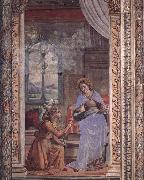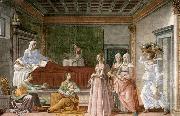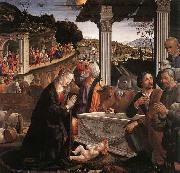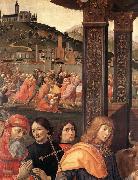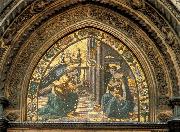
|
Artists
Index
|
||
|
Domenico Ghirlandaio
|
||
|
Annunciation new21/Domenico Ghirlandaio-352659.jpg Pintura identificación:: 62403 |
1486-90 Fresco Cappella Tornabuoni, Santa Maria Novella, Florence At the height of the Presentation of the Virgin and the Marriage of Mary - above the corner of the chapel and connecting with the rear wall next to the Gothic window - there is the narrow fresco the Annunciation. Again Ghirlandaio has moved the scene of this biblical event to Tuscany and his own era. He was able to find the traditional Renaissance form of a painted window with a view of a landscape in many Florentine palaces. They can still be seen today in Florence, examples being the palaces of the Medici, Ruccelai and Strozzi families. The angel is derived from the Annunciation painted by the young Leonardo da Vinci between 1472 and 1475, now on view in the Galleria degli Uffizi. In contrast to Leonardo's horizontal format, in Ghirlandaio's fresco in the predetermined vertical format his Virgin may be depicted facing the observer in an equally frontal view, but she is standing upright. She is therefore reminiscent of the beautiful picture on the same theme by Lorenzo di Credi, an artist who was also taught by Verrocchio together with Leonardo and Ghirlandaio | |
| |
|
|
|
|
||
|
Birth of St John the Baptist new21/Domenico Ghirlandaio-242648.jpg Pintura identificación:: 62404 |
1486-90 Fresco Cappella Tornabuoni, Santa Maria Novella, Florence The Birth of St John the Baptist and the Zacharias Writes Down the Name of his Son can be found on the second level of the right wall. The scene is described by Vasari. "... the birth of St John, with a beautiful idea that, while Elisabeth is in bed and being visited by her neighbours and a nurse is suckling the child, a woman is eagerly calling the attention of the visitors to the wonder that has come to her mistress in her old age; and lastly there is a woman bringing fruit and wine from the city, in conformity with the Florentine custom. This is very fine". In the Birth of Saint John the Baptist Ghirlandaio once again created a room flooded with light and air. We can well imagine that the palace rooms of Ghirlandaio's patrons being similar to this. In this picture he makes use of contrasting complementary colours by placing the red bedspread in front of the green wall hanging. In front of the wall hanging, a maid dressed in red and green is carrying a tray with carafes of water and wine for the refreshment of the woman in childbed. The golden orange hues of the pilasters and entablatures form a complementary contrast with the light blue of aged Elizabeth and the young maid coming in from at the far right. Such colour schemes help to create the captivating clarity that characterizes so much of Ghirlandaio's work. It is not just the age of Elizabeth and her maid that contrast, but also their respective auras of stillness and movement. Nowadays it is astonishing to think that Savonarola, the severe preacher of repentance, could have taken exception to this superb maid. She corresponds to the nurse on the far left, who is stretching out her arms eagerly. The two figures form an exciting frame for the quiet scene taking place in-between. In the Birth of John the Baptist, Elizabeth is visited by female representatives of the donor family - as is Anne in the birth scene on the opposite wall. The only figure that can be identified is that of the poet Lucrezia Tornabuoni, who was known for being very virtuous. She was the mother of Lorenzo de' Medici and a friend of the humanist Agnolo Poliziano and Luigi Pulci, portrayed in the Sassetti Chapel together with her son. There is actually nothing in this scene to suggest that it is depicting an event from the story of St John - with the sole exception of the severely weather-beaten halo surrounding Elizabeth's head. In this scene from everyday life, Ghirlandaio surpassed even his beautiful Birth of Mary. In addition to the marvelous basket of fruit, he added another two still-lifes to the picture in order to make it appear more home-like and realistic. On the far left two objects, a brass jug and bowl, that we are already familiar with from the fresco the Last Supper in the church of Ognissanti, and from the frescoes in the Santa Fina Chapel. At the top of the bed's headboard, next to the window, there is a symmetrical arrangement of a box, two pomegranates and a vase, reminiscent of both Saint Jerome's study and the frescoes in the Saint Fina Chapel. All these things once again bring Flemish painting to mind, which during this period made widespread use of everyday secular details as accessories. The miniature depicting the birth of Saint John the Baptist in the Turin/Milan Book of Hours is an outstanding example - a superb work that was most probably painted by Jan van Eyck himself, though its attribution is just as disputed as its date. Author: GHIRLANDAIO, Domenico Title: Birth of St John the Baptist , 1451-1500 , Italian Form: painting , religious | |
| |
|
|
|
|
||
|
Adoration of the Shepherds new21/Domenico Ghirlandaio-455374.jpg Pintura identificación:: 62410 |
167 x 167 cm Santa Trinit? Florence "He painted in tempera, as a companion to this work, a Nativity of Christ which must excite the wonder of every thinking man, introducing his own portrait and some heads of shepherds, which are considered divine" (Vasari). The Sassetti Chapel is consecrated to the birth of Christ, and as a result much in the chapel is conceived with that event in mind. The altarpiece the Adoration of the Shepherds is the chapel 's key work not only in subject, but also in artistic merit. This composition was so successful that other artists frequently repeated it. Ghirlandaio himself appears in the scene, dressed as a shepherd. He is even allowed to come closer to the Christ Child than the donors, who appear in frescoes to the right and left, praying outside the confines of the panel. The artist, who is leading the shepherds, is kneeling and bringing the miracle of the birth of Christ to the attention of both the shepherds and the observers of the picture. His left hand, with which he is pointing to the Christ Child, is finely drawn and is superbly modelled in three dimensions. With his right hand, his painting hand, he is pointing to his chest, as he does in a later fresco in the Tornabuoni Chapel. As Ghirlandaio is pointing both at the child and the garlands on the Roman marble sarcophagus, it is possible that the gesture is saying: "This holy child was painted for you by me, the garland-maker Ghirlandaio." The classical sarcophagus in the picture is not just a manger for the ox and ass. It also has an iconographical significance indicated by the Latin inscription along its front: Ense cadens. Solymo. Pompei Pului[us] Augur Numen. Ait. Quae me conteg[it] Urna Dabit. [While Fulvi(us), augur of Pompey, was falling by the sword in Jerusalem he said: the urn that covers (conceals) me shall bring forth a god]. This is an ancient prophecy by Fulvius. The animals' manger will serve as a crib for the Christ Child. In his Adoration of the Shepherds, Ghirlandaio combines this reference to the Roman classical age with knowledge of Flemish art and turns them into an integrated whole. An historic event that took place a few years before this work was painted clearly left its mark behind on Ghirlandaio's work. An altarpiece ordered by Tommaso Portinari from Hugo van der Goes in Bruges reached Florence in May 1483. Florentine artists saw van der Goes' Adoration of the Shepherds as a shining comet showing new ways of painting. In Ghirlandaio's altarpiece, the shepherds pushing their way into the picture from the right, with their harsh, life-like features, are drawn directly from this Flemish model. Ghirlandaio's landscape in the background also displays features from north of the Alps | |
| |
|
|
|
|
||
|
Adoration of the Magi new21/Domenico Ghirlandaio-773597.jpg Pintura identificación:: 62412 |
1488 Tempera on wood Spedale degli Innocenti, Florence Ghirlandaio (second from the right) gazes out at us from this picture, more modestly than in his other self-portrait (like in the Tornabuoni Chapel or in the Sassetti Chapel). It is thought that the churchman dressed in black in front of him is the man who commissioned the panel painting, Francesco di Giovanni Tesori. Above these two portraits, the Slaughter of the Innocents in Bethlehem is shown. The town beyond this, in which we can see monuments such as the Colosseum, Trajan's Column, the Torre del Milizie, and a pyramid, is meant to be reminiscent of Rome | |
| |
|
|
|
|
||
|
Annunciation new21/Domenico Ghirlandaio-743869.jpg Pintura identificación:: 62999 |
1489-90 Mosaic Porta della Mandorla, Duomo, Florence In addition to the fresco in the Tornabuoni Chapel, Ghirlandaio created another Annunciation between 1489 and 1490 using the ancient mosaic technique, which he had learnt from Alessio Baldovinetti and which he had been able to employ when restoring a few old mosaics. There is no lectern in this mosaic version of the Annunciation, though the influence of Leonardo's painting is still felt, particularly in the spatial arrangement - a building on the left behind Mary and a view over a wall to a landscape. Above the Porta della Mandorla on Florence Cathedral there still exists this mosaic. Vasari wrote the following comment on it: "Domenico enriched the modern art of working in mosaic infinitely more than any other Tuscan, as his works, though few, amply demonstrate...". Of this mosaic destined for the Porta della Mandorla Domenico only executed the cartoon, which was probably translated into mosaic by his brother David. Artist: GHIRLANDAIO, Domenico Painting Title: Annunciation , 1451-1500 Painting Style: Italian , , religious | |
| |
|
|
|
|
||
| Previo Artista Próximo Artista | ||
|
Also Buy::. For Following Paintings / Artists / Products, Please Use Our Search Online: |





